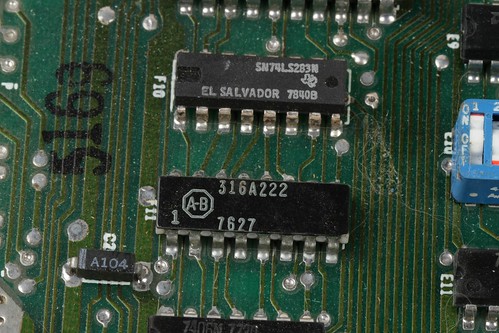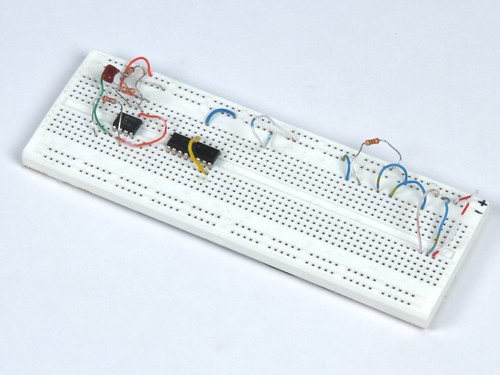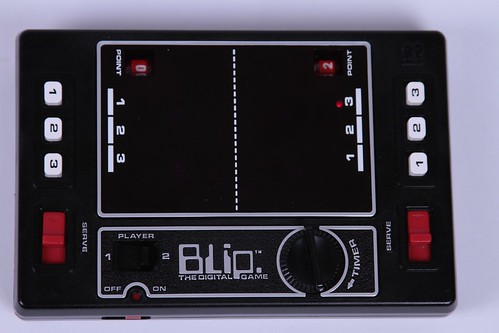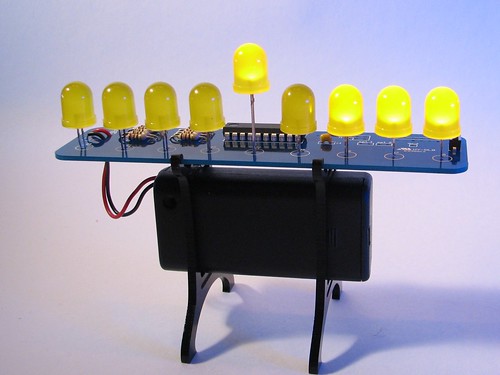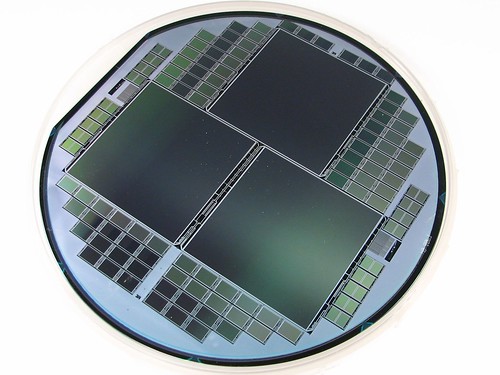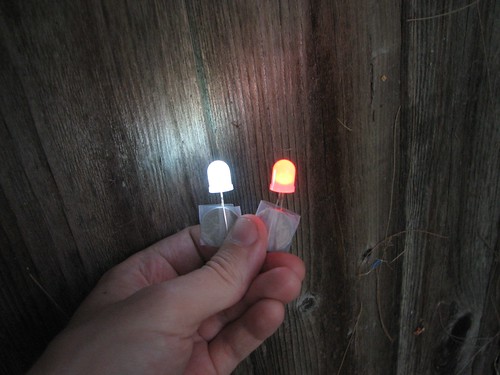You’ve got your components, and your datasheet, and you’re read to start hacking. But which way does the chip go? Pin 23 is where? If you’re lucky, the orientation is clearly marked, or perhaps diagrammed in the datasheet. But if it isn’t, or if you’re simply new at this, it’s helpful to know what to look for. Continue reading Basics: Finding pin 1
Tag Archives: electronics
Faking it: seven-segment displays
A sordid tale, starting in the bedroom, involving batteries, deceit, cheap tricks, LEDs, and a pot.
Continue reading Faking it: seven-segment displays
Mailbag: Moving from breadboard to protoboard
Ryan writes in,
| “I have a question about moving a project off a bread board and onto a project or perf board. Basically what is the best way to do without a lot of rework? This will be my first time doing this and I was just wondering if there were any best practices so that the final product looks clean and organized and I don’t have mountains of solder on the back side.” |
And it’s a good question.
Continue reading Mailbag: Moving from breadboard to protoboard
What makes Blip tick?
After our Tabletop Pong project, someone suggested that we should check out the Tomy Blip, a handheld game dating to 1977.
And so we did. We snagged one on eBay, and here it is: “Blip, the digital game.”
Blip is unlike any other handheld that I’ve played, and (as you’ll see) it’s quite a piece of engineering. In what follows, we give it a test drive, and then take it apart and see what makes it tick.
Continue reading What makes Blip tick?
Deck the halls with fine components
Ever since our wine charm project, we’ve been amassing an ever-growing collection of interesting-looking electronic components. It turns out that they happen to make pretty good Christmas tree ornaments.
New LED Hanukkah Menorah Kit
One of our first kit projects, and one of the consistently most popular, has been the LED Mini Menorah project. For a couple years now we have meant to revisit that project, and we’ve finally got around to doing so. Here is the result: our new Deluxe LED Menorah Kit.
An interesting wafer
I picked up this interesting wafer at the silicon valley electronics flea market. So far as I can guess, these are some sort of image sensors. The manufacturer has cleverly divided the wafer up to make three different sizes of sensors at the same time– only three of the large ones, and many more in the two smaller sizes.
So, before I pull out the microscope and look for brand names, can anyone guess (or identify) *exactly* what we’re looking at here? For scale, the wafer is about six inches across. A few more pictures follow.
Continue reading An interesting wafer
Some thoughts on throwies
We’re big fans of LED throwies and derivative projects where you light an LED simply by connecting it across the terminal of a small lithium coin cell.
You’ll find this trick used in a lot of our projects that call for simply lighting up an LED in a tiny space, like the temporary LED lanterns, LED Ghosties, Robogames awards,
LED origami circuitry, light-up Lego minifigures, and edge-lit holiday cards. You’ll also find them in those little keychain flashlights– open one up and there’s just a battery and an LED.
So the throwie (and I use the term loosely, referring to devices with or without magnets) is a darned useful thing. But the first time that I was introduced to the concept, I asked what a lot of other electronics-oriented people do: “where’s the resistor?”
Turns out that it’s a fair question. LEDs aren’t normally driven directly from a battery. And yet (1) people were making throwies with every imaginable color of LED and (2) they apparently weren’t exploding. So what’s the deal?
TGIMBOEJ: One year later
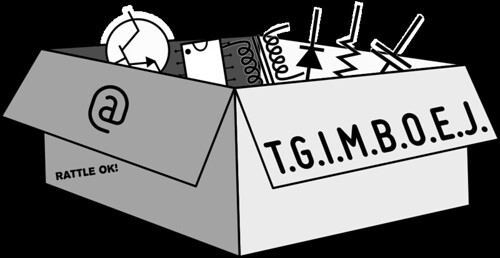
One of the big projects that we launched in 2008 is The Great Internet Migratory Box Of Electronics Junk, a pay-it-forward style hardware sharing program for electronics.
Since our original article, TGIMBOEJ (pronounced Tig-Ihm-Boh-Edge) has somewhat taken on a life of its own. In that article, we set up simple guidelines for how to pass the box along, and in the interim we have taken a “laissez-faire” approach, watching and learning from the successes and troubles with that model.
Our mostly-hands-off approach to supervising TGIMBOEJ has worked remarkably well in some respects. There are upwards of 40 circulating boxes now, which have passed through hundreds of hands. And, hundreds of other people have signed up on our wiki site tgimboej.org as potential recipients.
On the down side, the mean free path of many of the boxes has been far too short– some have made it just one hop before stopping.
In talking to folks about the boxes that got stuck, we identified three main stories (all of which point us towards fairly obvious solutions):
1: “I sent it to some guy, but I haven’t heard anything since then.”
2: “Oh yeah– I’ve been meaning to ship it for some time.”
3: “I got this box and I don’t know what to do with it.”
So now, it’s time to get serious. First, we’ve been contacting the last known recipients of the stalled boxes, and trying to get more of the existing boxes back into circulation. Second, we’re relaunching the tgimboej.org wiki site with a wholly new set of participation instructions and procedures.
To keep boxes in circulation longer, we’re now encouraging that boxes should be sent to people who have specifically requested to participate— i.e., people who are familiar with how the project works. We’ve also introduced language in the revised instructions that will guide participants to keep an eye on their box, even after it leaves their hands.
To further alleviate the potential problem of people ending up with boxes but not knowing what to do with them, we’re standardizing the printed materials that go into each new box.
Gone are the cute but scrawled little notebooks, replaced by two neat PDF forms– one to log the progress of the box, and the other with detailed instructions on how to participate.
Finally, we’re launching eight new TGIMBOEJ boxes this week, which — along with the others that are coming back into circulation — will help to increase the number and rate of box exchanges.
So now it’s your turn. If you would enjoy trading electronics with like-minded individuals, this is becoming a great time to participate in The Great Internet Migratory Box Of Electronics Junk.
To get started, please read about how it works on the TGIMBOEJ wiki, and if you’re game, add your name to the list of Box Requests.
Meggy Jr RGB Twitter Reader

We’ve turned Meggy Jr RGB into a multicolor scrolling LED twitter reader. It’s a handy external ambient data device that displays things recently written by your friends on twitter.
This project was inspired in part by the excellent Twitter LED Scroller by David Nichols. The big idea is that we use a host computer to run a Processing application, which periodically checks Twitter for updates, and then sends “scrolling” data, one column at time, to the external LED display.
Continue reading Meggy Jr RGB Twitter Reader




